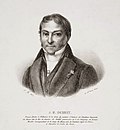| 解説 |
English: An Indian lying down displaying his extreme skill in handling the bow and arrow. It occupies the center of the image, however, a little distant, stands another Indian in the same position and, farther back, a third archer, standing, also shoots his arrow in the wild and natural landscape, in which no sign of colonizers can be identified.
If the image (nudity, use of indigenous weapons, wild landscape) could suggest that we are in front of a "wild Indian", the title of the painting of Caboclos or civilized Indians and the text to which it corresponds, Village of São Lourenço, leave no doubt about the classification given by Debret to the characters: these are caboclos - "civilized Indians", generic name that, in the province of Rio de Janeiro, was given to "every civilized and baptized Indian."
The archer was the object of Debret's gaze, a caboclo of São Lourenço, who lived in intense contact with colonial society, yet maintained his skill with the bow and arrow and placed himself in that manner to attract the admiration of foreign travelers. According to the description, it was common to find them among the civilized of the villages, Indian archers, perhaps disdainful, interested in exhibiting their dexterity to the strangers who passed by. If that was the goal, it seems to have been achieved, at least with Debret. The cited text evinces the admiration of the artist for the Indian's ability, evidence reinforced by the option to portray him, associating it in the text about the village of São Lourenço
Español: Un indígena acostado exibiendo su extrema habilidad en el manejo del arco y flecha. Ocupa el centro de la imagen, sin embargo, un poco distante, se destaca otro índio en la misma posición y, más retirado, un tercer flechero, en pie, también lanza su flecha en el paisaje natural y salvaje, en el cual no se identifica ninguna señal de colonizadores.
Si la imagen (nudez, uso de las armas indígenas, paisaje salvaje) podría sugerir que estamos delante de un "índio salvaje", el título de la pintura de Caboclos ou índios civilizados y el texto a que ella corresponde, sobre poblaciones indígenas de la aldea de São Lourenço, no dejan dudas sobre la clasificación dada por Debret a los personajes: se trata de índios civilizados caboclos, nombre genérico que, en la provincia de Río de Janeiro, era dado a "todo índio civilizado y bautizado".
El flechero era, entonces, el objetivo de la mirada de Debret, un caboclo de São Lourenço, que vivía en intenso contacto con la sociedad colonial, sin embargo, mantenía la habilidad con el arco y la flecha y se colocaba de aquella forma para atraer la admiración de los viajantes extranjeros. De acuerdo con la descripción, debía ser comun encontrarles entre los civilizados de las aldeas, índios flecheros, quizás desdnudos, interesados en exibir su destreza a los forasteros que por allí pasaban. Si el objetivo era ese, parese haber sido logrado, al menos con Debret. El texto citado evidencia la admiración del artista por la habilidad del índio, evidencia reforzada por la opción de retratarle, asociandolo en el texto sobre la aldea de São Lourenço. [1] |






